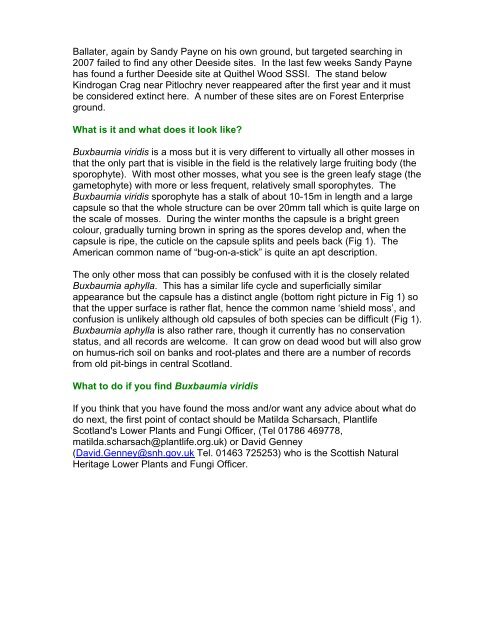Buxbaumia viridis leaflet - Plantlife
Buxbaumia viridis leaflet - Plantlife
Buxbaumia viridis leaflet - Plantlife
You also want an ePaper? Increase the reach of your titles
YUMPU automatically turns print PDFs into web optimized ePapers that Google loves.
Ballater, again by Sandy Payne on his own ground, but targeted searching in2007 failed to find any other Deeside sites. In the last few weeks Sandy Paynehas found a further Deeside site at Quithel Wood SSSI. The stand belowKindrogan Crag near Pitlochry never reappeared after the first year and it mustbe considered extinct here. A number of these sites are on Forest Enterpriseground.What is it and what does it look like?<strong>Buxbaumia</strong> <strong>viridis</strong> is a moss but it is very different to virtually all other mosses inthat the only part that is visible in the field is the relatively large fruiting body (thesporophyte). With most other mosses, what you see is the green leafy stage (thegametophyte) with more or less frequent, relatively small sporophytes. The<strong>Buxbaumia</strong> <strong>viridis</strong> sporophyte has a stalk of about 10-15m in length and a largecapsule so that the whole structure can be over 20mm tall which is quite large onthe scale of mosses. During the winter months the capsule is a bright greencolour, gradually turning brown in spring as the spores develop and, when thecapsule is ripe, the cuticle on the capsule splits and peels back (Fig 1). TheAmerican common name of “bug-on-a-stick” is quite an apt description.The only other moss that can possibly be confused with it is the closely related<strong>Buxbaumia</strong> aphylla. This has a similar life cycle and superficially similarappearance but the capsule has a distinct angle (bottom right picture in Fig 1) sothat the upper surface is rather flat, hence the common name ‘shield moss’, andconfusion is unlikely although old capsules of both species can be difficult (Fig 1).<strong>Buxbaumia</strong> aphylla is also rather rare, though it currently has no conservationstatus, and all records are welcome. It can grow on dead wood but will also growon humus-rich soil on banks and root-plates and there are a number of recordsfrom old pit-bings in central Scotland.What to do if you find <strong>Buxbaumia</strong> <strong>viridis</strong>If you think that you have found the moss and/or want any advice about what dodo next, the first point of contact should be Matilda Scharsach, <strong>Plantlife</strong>Scotland's Lower Plants and Fungi Officer, (Tel 01786 469778,matilda.scharsach@plantlife.org.uk) or David Genney(David.Genney@snh.gov.uk Tel. 01463 725253) who is the Scottish NaturalHeritage Lower Plants and Fungi Officer.
















